Many colonial pattern sun helmets featured a spike at the dome, a feature reminiscent of the German “Pickelhaube” (Pointy Hat). This traditional of wearing a spike is one that appears to originate in the 1840s, and while a helmet with a spike on top is traditionally associated with Prussia and later Germany, the truth is that many nations including the United States, Great Britain, Portugal, Spain, Norway, Sweden and Chile all were among those that utilized the decorative spike.
But the first nation may have been Russia, which introduced a helmet around 1841. An often repeated story suggests that Prussian King Frederick William IV visited his cousin Czar Nicholas I of Russia in St. Petersburg, and here the Prussian King saw the first of these helmets worn by Russian soldiers. These were reportedly based on traditional Russian helmets used in the Middle Ages, which were themselves highly influenced by Tartar and Mongolian helmets.
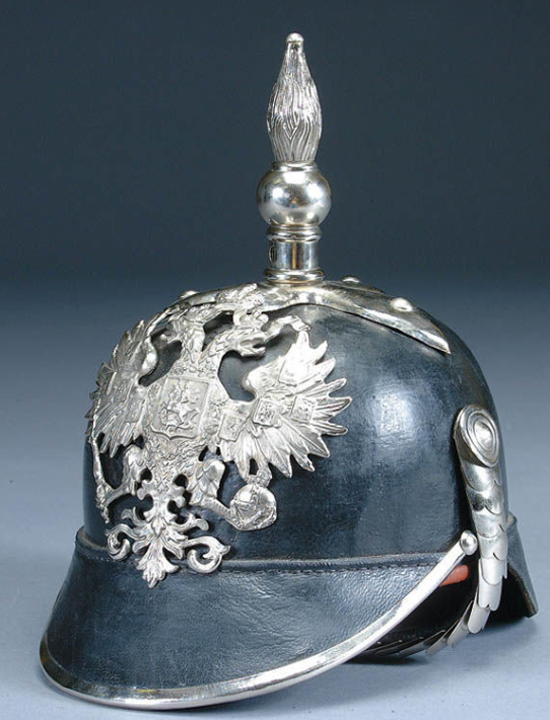
A Russian Model 1840 helmet. Note that the shape is similar to the above latter pattern Canadian Universal Pattern Sun Helmet.
This is especially noteworthy as the British Home Service Helmet, which was adopted in 1878 was likely based and/or influenced on the Foreign Service Helmet that originated in India prior to the Indian Mutiny of 1857. There remains debate over how much influence the German Pickelhaube may have had – or not had – on the design of the British Home Service Helmet with its spike. It is important to remember that the Russian military did use spiked helmets during the Crimean War (1854) and thus prior to the Indian Mutiny.
The Turko-Mongol influence was especially strong in India, notably so in the areas of the Mughal Empire, which was in decline during the latter part of the 18th century and finally was abolished following the Indian Mutiny. This influence was seen throughout the sub-continent, with groups such as the Rajput adopting a helmet with a spike in 13th century.
The Kulah Khud helmet of Indo-Persian origin was also used throughout the region, including in ceremonial purposes as late as the early 20th century. Thus the use of “spikes” on helmets existed for centuries prior to either the Crimean War or the Indian Mutiny.
The British were likely exposed to such headgear in its dealings with the Turks – who also utilized a helmet similar to the Kulah Khud at the time of the Crimean War for ceremonial purposes – while at the same time Russia was expanding into regions in Central Asia, including some lands that also had a Turko-Mongol influence. Thus it should be accepted that both the British and Russians were exposed to helmets with spikes around the same period.
Moreover it is likely that this influence occurred around the same time, and while the British may have followed the trend in adopting a spike on its helmets it wasn’t likely a direct influence from the German Pickelhaube, which itself was based on the Russia pattern.
Rather it should be accepted that the style caught on much as a fashion trend that saw similar shaped helmets replacing the shako, which had been the de facto standard of headgear around the world. As nations looked to “modernize” it was very much a case of out with the old and in with the new. In the 1850s to 1870s that appears to be a pointy spike on the top of the helmet!
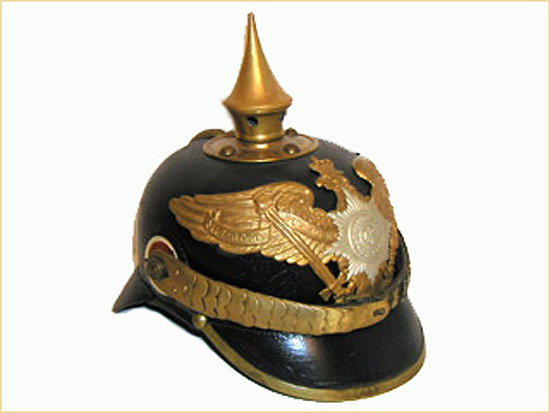
A Prussian Model 1891 NCO’s Guard Infantry Pickelhaube. Note that while the spike is thicker and this helmet is made of leather it does have a similar profile to the British Home Service helmet. This pattern is an update of the Model 1867 version, which was in fact introduced 10 years before the British helmet.
Peter Suciu

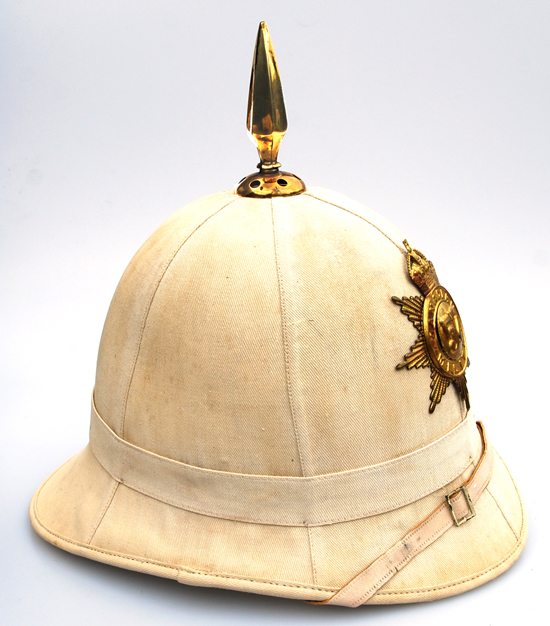
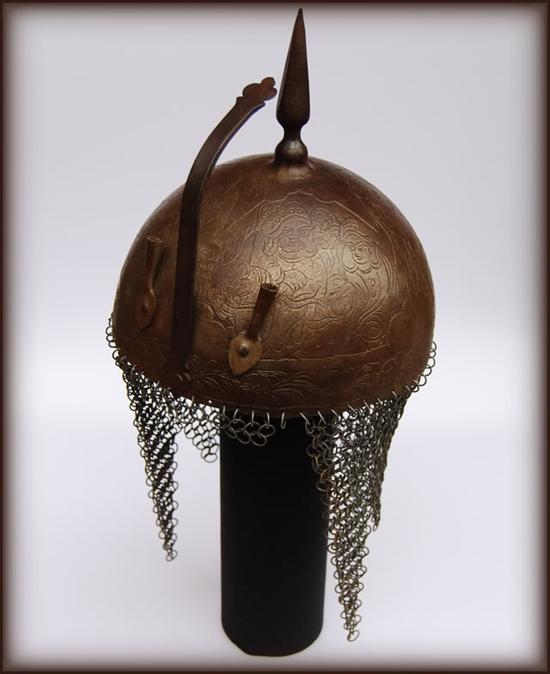
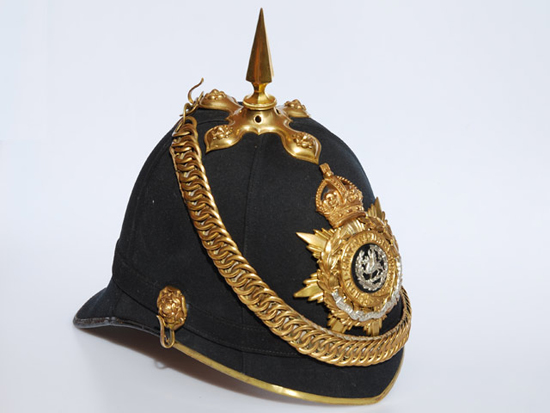
Just came across this a little late. I’ve been slightly annoyed by the ‘copied from the pickelhaube’ thesis for years now. For me the home service helmet was a synthesis of the Indian pattern cork helmet and the 1871 pattern cavalry helmet, possibly with the influence of the already established police helmet lingering in the background. The distinctive British helmet shape goes back through the 1871 pattern to the Albert pattern of the early 1840s (which is obviously the same creature as the 1871 but didn’t even have a spike as such – rather a plume holder). This in turn was obviously derived from the 1834 pattern helmet (same skull shape, same pointed peak, rear peak). Of course, this had a crest rather than a spike, but for me is clearly a direct model for the subsequent helmet. This is significant as it predates both the Russian and Prussian spiked models.
G’Day Peter, I really don’t know much about this web info & email bit, or if the posting is too long ago, but just in case you do actually read it, my I first say, ‘Thanks to you & your compatriots on the site; you’ve done an amazing job. The info is very much appreciated’. I’ve only just started on ‘Sun Helmets’ so any assistance is just super. Peter, can you tell me if the photo of the Kulah Khud helmet you use in the story is one of your own, or if it’s a ‘stock’ photo from somewhere else? It’s just that I have that very same Kulah helmet. Now that maybe because all ceremonial helmets were given the exact same motif, or a hundred other reasons for that matter, but as I have it (or one like it) I jusy wanted to find out a bit more about it. Also, I have a Post WW2 Belgian Navy Sun Helmet & any info source you could direct me to would be invaluable too. Thanks Peter & blessings to you. Cam
The Russian helmet shown here is of the 1857 model. The low height and style of eagle with its wings splayed upward and covered in provincial coats of arms is a dead giveaway. The Russian Guard and Army did not adopt a helmet until at the earliest May 9 / 17, 1844, where it replaced the shako. It’s shape was taller and more narrow, not unlike the Russian cavalry helmets of the Napoleonic wars and it’s eagle device had its wings turned down (almost trapezoidal), bore only the arms of Moscow in the centre, and with laurels and lightning in his talons and resting on an “Amazonian” shield bearing a regimental number.
https://upload.wikimedia.org/wikipedia/commons/a/a5/Русская_каска_обр.1844_г.jpg
I won’t speculate about how early the design itself was drawn up or whether the King of Prussia saw it and “stole” it for his own armed forces, but the fact is Prussia adopted it about a year and a half earlier than Russia did. The entry for the helmet’s adoption in 1844 can be found in the Complete Collection of Laws of the Russian Empire, collection 2 (1825-1881), volume 19, under entry No. 17907.